A few months ago, I was very excited to introduce you to G. Gerlach, one of very few Polish made watch brands (yes, there are more than one). I’ll defer to that article for details, but to summarize, Gerlach is setting out to revitalize manufacturing in Poland as well as pay tribute to Polish history via watches. The owners are a bunch of collectors with eclectic tastes who set out to make watches they want to wear as much as their customers would. As such, the watches range wildly from pilots, to marine chronometers to divers of various types. While that might seem like an odd strategy, they are doing a lot of things no one else is, and there is something in their line for everyone. And…they are doing it all with very affordable prices.
Following up their first set of the watches, which were altogether unique, Gerlach released the Otago, which we have the pleasure of reviewing today. This chunky orange-dialed diver clearly draws inspiration from classic 70’s divers, namely those of Doxa (they were the first with orange dials). As with all Gerlach watches, there is a tie-in to Polish history as this watch is dedicated to Joseph Conrad, born Józef Teodor Konrad Korzeniowski, the author of Heart of Darkness as well as many other titles and the boat he captained, the Otago. Though the watch itself refers to a decade much after his death, the case back features an etching in his honor.
The Otago, which is a limited edition of 250, is a cool-retro diver with 200m water resistance, sapphire crystal and a Seagull ST2551 automatic movement. With a price tag of around $360-70 (exchange rate depending), it’s certainly affordable for an automatic diver with sapphire. It’s easy to forget that as much as possible of the watch was made in Poland, including the case and strap. Considering they are clearly designing their own cases, and developing their own tooling, the price is all the more exceptional, though the Seagull movement might be less desirable than a Japanese or Swiss auto.
 Case: St Steel
Case: St Steel
Movement: Seagull ST2551
Dial: Orange
Lume: Yes
Lens: Sapphire
Strap: Leather
Water Res.: 200M
Dimensions: 42 x 50mm
Thickness: 15 mm
Lug Width: 22 mm
Crown: 9 x 5 mm
Warranty: 2 years
Price: ~$360
Case
The case of the Otago is a super 70’s barrel shape with a massive chunky bezel and crown to match. On a table, the watch looks huge, but the actual dimensions are much more tolerable at 42 x 50 x 15mm. The barrel-shape itself is sort of a blunted oval, where the flat parts act as lugs. The lack of the typical gap for lugs increases the massiveness of the case, but also makes it look stubbier. The top surface of the main portion of the case has a slight doming to it, softening the overall form, as well as radial brushing. The sides, however, are totally flat and polished.
The most pronounced element of the case is clearly the incredibly tall and somewhat dangerous looking bezel. The teeth along the edge of the bezel have a saw tooth shape, which is to say they are straight on one side and angled on the other. This makes the bezel grab your fingers very well when turning it in a count-clockwise direction, as bezels typically turn. It also gives it a very jagged and fierce look.
The mechanism, unfortunately, leaves a bit to be desired. Though stiff and sturdy, turning it feels like grinding metal together rather than sharp, machined clicks. It’s a 120-click mechanism, but it appears to be bi-directional too…either that, or it’s easy to turn the wrong way. In the end of the day, it gets the job done and is secure enough not to accidentally turn, which is most important, but it lacks that well-machined snap.
Equally as massive, the screw down crown at 3 is a statement maker. Measuring a whopping 9 x 5mm, the crown clearly was designed to hold up to the extreme bezel. Rather than having the typical coining that crowns feature, this one has five deep grooves that really dig into your fingers when you need to engage it. When screwed in, the crown is very stiff and secure, giving the watch a solid feel.
Flipping the watch over reveals perhaps the nicest detail of the watch. Though a simple etching, the back shows a large ship, sails full of wind, on water, with Joseph Conrad’s signature and an Otago logo. Around the scene are various details, including “Made in Poland” and the edition number. I really like that they went the extra mile to add art to the back of the watch. It ties in the Polish history and simply makes the watch feel more special. Little details make such a huge difference, and knowing that they could have left it off, probably saved money on development of the art and the etching process, but still charged the same no one being the wiser, let’s you know that this is a brand that cares about their goods and customers.
Dial
If the case of the Otago speaks to the 70’s, the dial screams it. Heavily influenced by Doxa designs, the dial features an orange central surface encircled by a simple, but attractive, index. The orange color is a bit different that expected, I must say. It’s not that fluorescent, creamy orange that is typical, but rather something more metallic verging on copper tone.
Around / on top of the orange is a ring of black, on which is the primary index of applied markers. The markers are very large and made of polished steel with a stripe of lume down the center. Each marker protrudes a bit into the orange, giving it a sort of gear shape that is actually similar to the shape of the crown. The markers are longer at 12, 6 and 9, with an implied longer marker at 3, though it is cut by a date window. This was actually very well done as the dial manages to feel maintain symmetry despite there being a 3 ‘clock date. The orange center also has some printing on it. There are cross-hairs running 12-6 and 3-9, reinforcing the dial’s symmetry, as well text below 12 and above 6. The text is minimal and does not interfere with the design or look.
The index of the bezel is strangely designed, also having a very retro/70’s feel. There are large squares cut in, which match the width of the markers on the dial, alternating with narrow rectangles every 10 minutes. For the first 20 minutes there is a sort of train-track like minute index that runs through the other markers. Each of the large squares, except 0/60 also has a numeral in it. The curious thing about the design is how the markers are literally filled in with white lume. You can actually see how the lume sinks in the center of the marker a tiny bit as the liquid settled while hardening. Though I haven’t seen this on vintage watches, it nevertheless makes the watch seem more of a different era… just because it seems like an old-fashioned way of doing things.
The hands of the watch are pretty straightforward, but adequately bold to stand up to the dial and case design. The hour and minute hands are wide fence posts in black with lume filling and the seconds hand is a long, tapering stick that is wider at the center than most seconds hands typically are. It’s a nice design, actually, giving the seconds more presence than a thin stick. It also has lume on its tip. The lume on the watch overall is not particularly strong. It charges quickly, but doesn’t get very bright or last long. There is also a bit of “spotty” quality to it in larger areas.
Movement: Seagull ST2551
One of the interesting facets of the Otago, as well as other G. Gerlach watches, is that it uses a Chinese made Seagull ST2551 movement. The ST2551 is a 25-jewel automatic with hand winding, hacking seconds, date, 48-hour power reserve and a frequency of 21,600bph. This is the first watch we’ve reviewed on w&w that has used this movement, and in our time with the watch, we’ve seen no issues. The 21,6k frequency does result in a less smooth seconds hand that the 28,8k ETA 2824-2s, Miyota 9015s and Selitta SW200s, we typically see, though that does not effect the overall quality. At the same time, it actually has a longer power reserve at 48hrs, as the others teeter around 40.
Use of the movement is as expected. Pull the crown out one stop to change the date by turning it clockwise, pull it out two stops to change the time.
Straps and Wearability
There a few strap options at purchase, but ours came on a 22mm black leather strap with orange stitching. The leather is stiff and decent quality with a nice pebbled texture that also has a retro vibe. The black and orange clearly tie in with the dial design, giving the watch a complete look.
The watch wears very nicely, having good proportions and an easy to tolerate size, despite its chunky look. On my 7″ wrist, I found the 42 x 50mm case did not overwhelm or feel too big. The 15mm height is quite tall, but suits a sport/diver. The look of the watch is very fun and a bit wild. Orange is clearly a bright and shocking color that garners attention, so this watch definitely stands out. The 70’s aesthetic then adds some additional funkiness to the whole picture. A lot of vintage styled watches tend to borrow from the elegant-modern designs of the 50’s and 60’s, which blend in well with today’s looks. The Otago is from a time when shag carpet, bell-bottoms and wide-pointed collars were in style, so it does look a bit odd with modern apparel. That said, as a stylized sport watch, it is very different from what else is out there, especially in this price range.
Conclusion
My favorite thing about the Otago is not necessarily the watch itself, but the watch as evidence of a very exciting brand. As a Polish watch brand using Asian movements and manufacturing locally, G. Gerlach can set their own tone for what they want to do. A watch like the Otago would likely never be made by a Swiss or German brand, even an affordably minded one like Steinhart. It’s a bizarre watch that is a throw back to an era when watches were kind of strange looking. The orange dial is a love it or leave it detail as to some, orange just isn’t appealing. But the package as a whole, as an affordable watch, is pretty awesome. And, to be fair, the watch is available with a grey dial that is much more low key.
The price of $360-70 is great for a 200m automatic with a sapphire crystal. Frankly, I would expect a higher price, say 500-600, all things considered. Had the watch had a Miyota or Seiko movement inside, I don’t think anyone would scoff at that number. That said, one can likely find an Asian made diver with a Miyota 8xxx series for around $360, but it would probably use a generic case and not tell a story like the Otago. Details like the case back and very limited numbers, make this watch pretty special in its own way. So, should the 70’s style be your thing, you are interested in supporting this brand and Polish manufacturing, or you just like orange, the Otago is a fun and affordable watch to get. If not, G. Gerlach has many other watches out and many on their way that we are very excited for and will hopefully get to feature.
by Zach Weiss
review unit supplied by G. Gerlach









 Featured Videos
Featured Videos




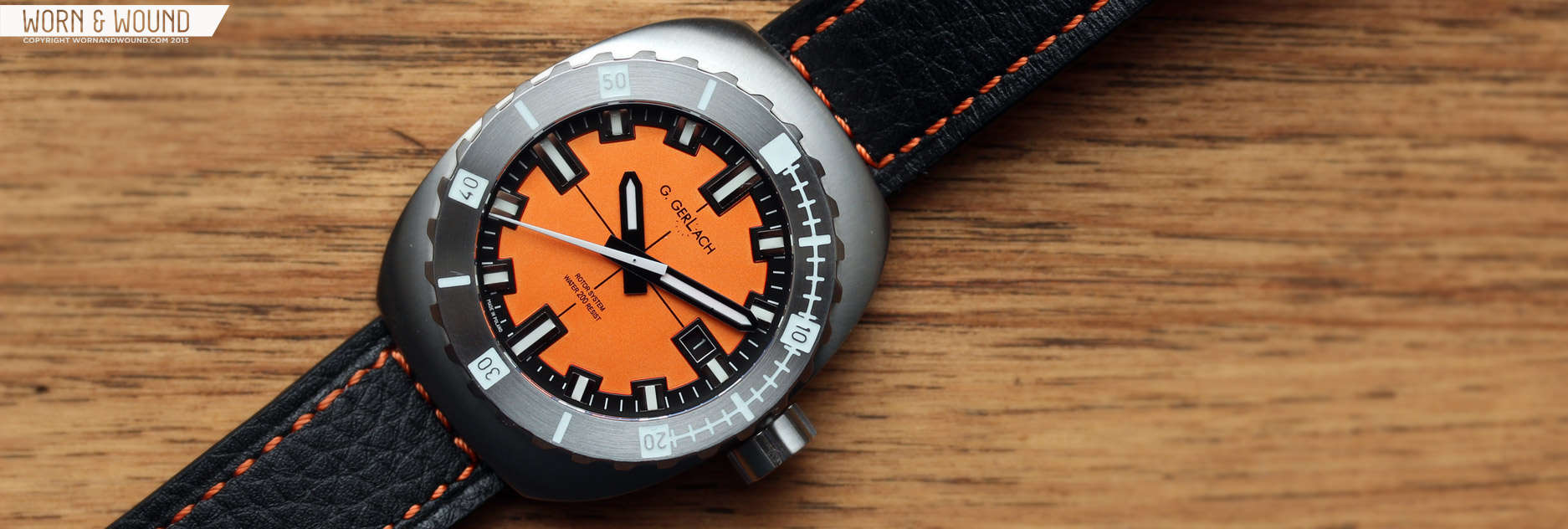
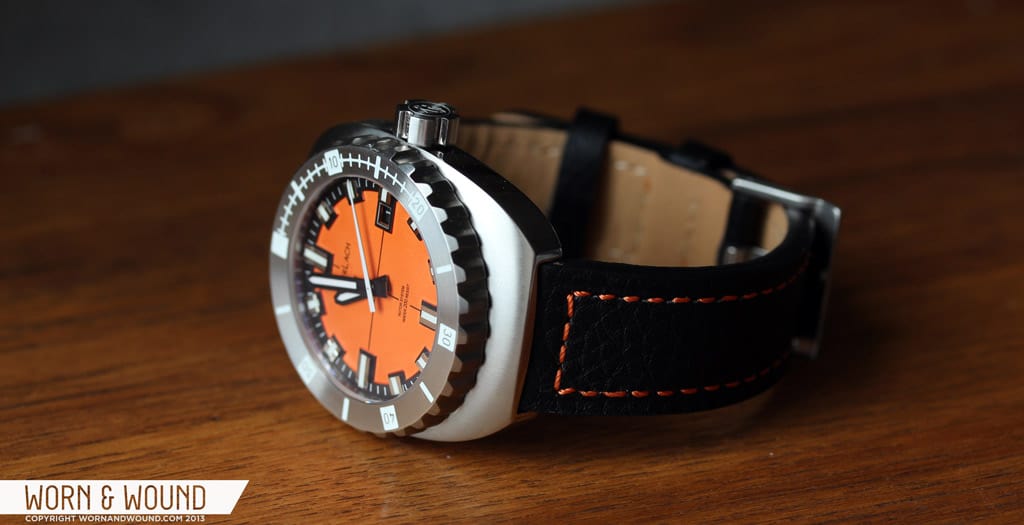
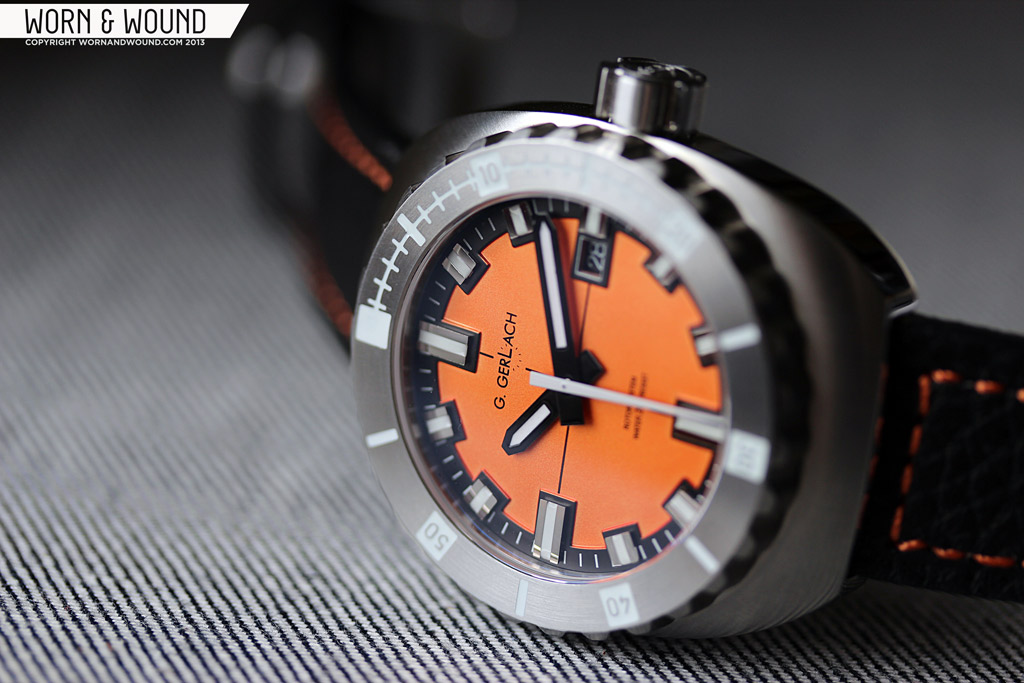
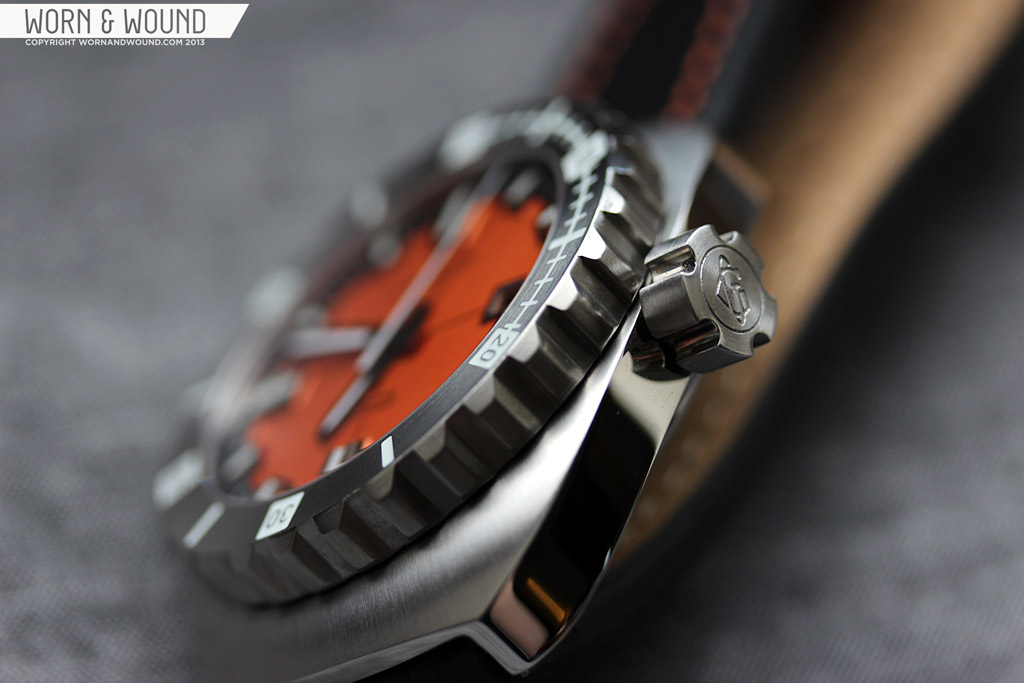
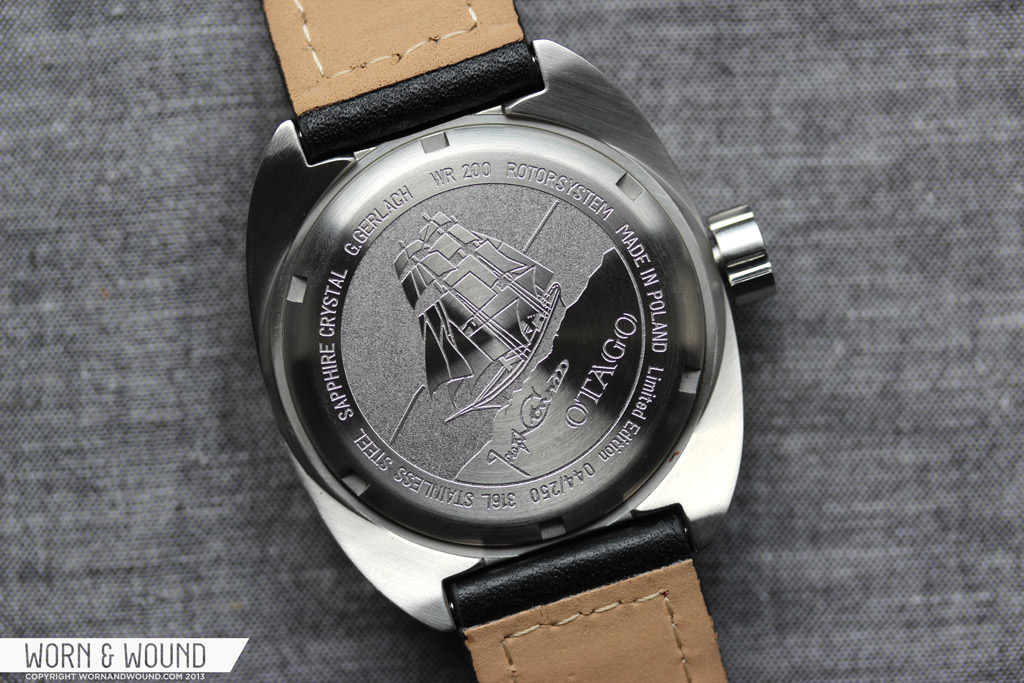
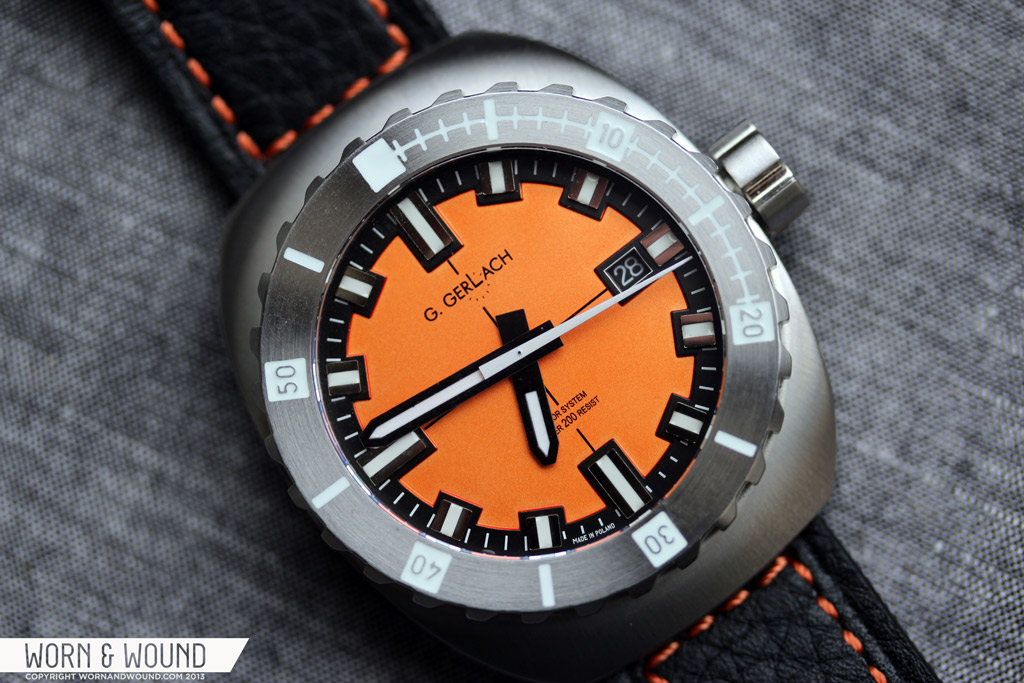

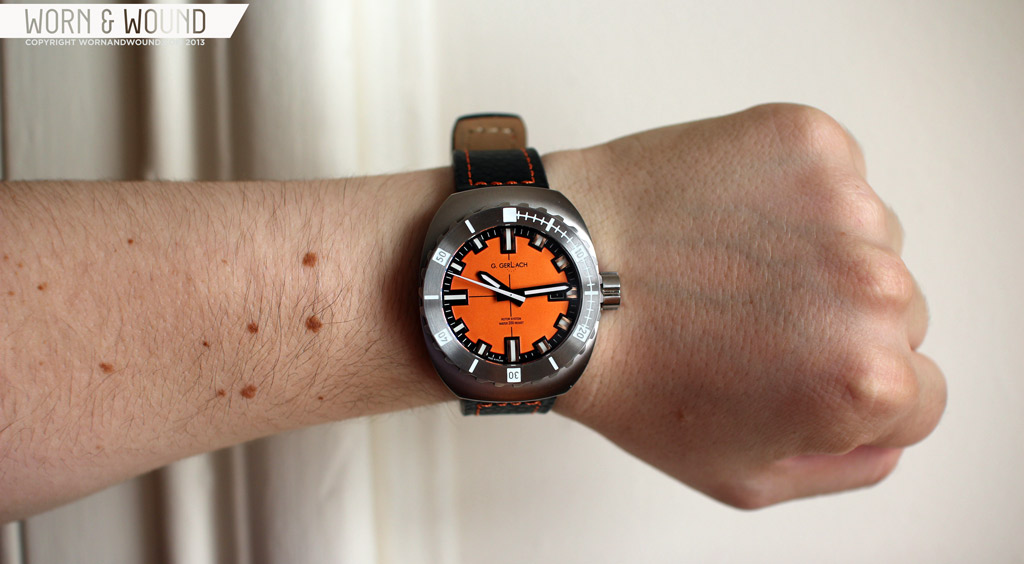
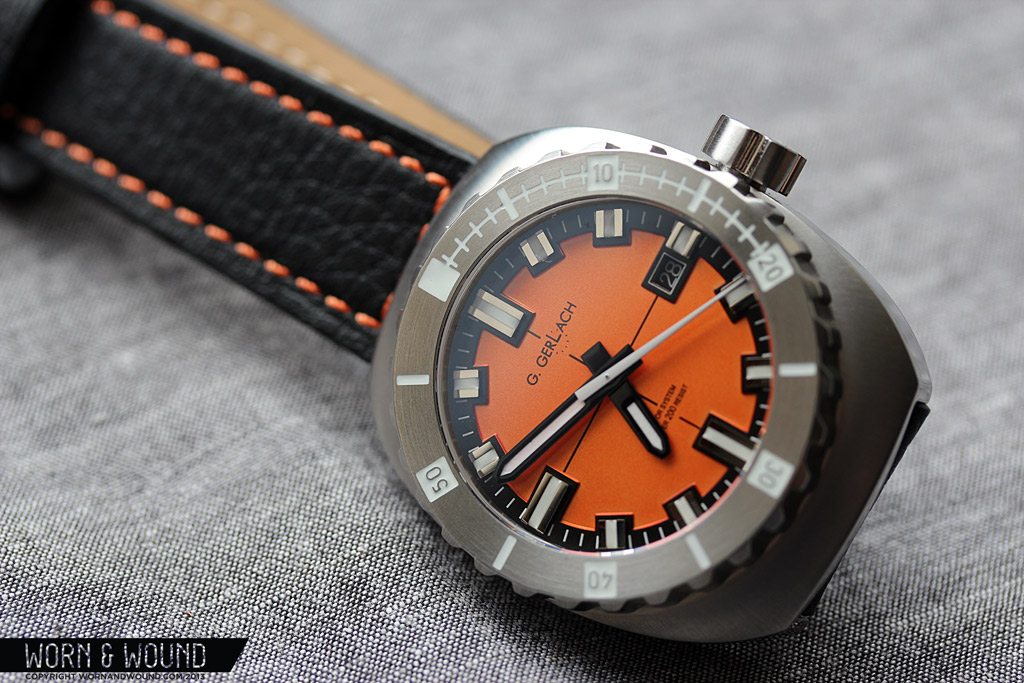

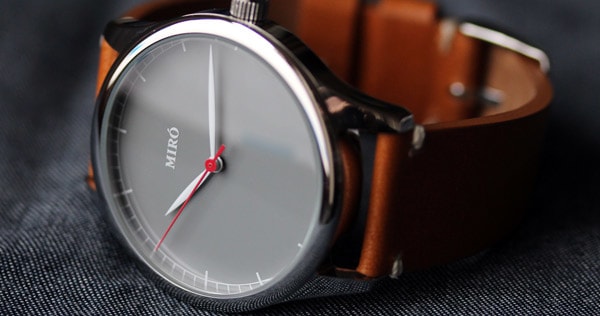

I really enjoy his work. I have been wanting an Otago for a while, but I really also like the Batory and RWD 6. Sadly, I won’t be able to order any watches anytime soon due to expenses. His upcoming bullhead chronograph (called the Auroch) really has my eye, though, and I think I’m going to save up for that.
Wow! The Auroch is really something! I’ve been eyeing the big date Batory pretty closely as I’ve always loved marine chronometers… but their dual crown Navigator that’s in the works is also pretty fantastic… the diversity of their designs really sets this brand apart.
-Zach
The Auroch project looks amazing! It was limited to only 113 pieces (and all have been sold in preorder).
You can find some photos of how this watch will look like here:
https://www.facebook.com/media/set/?set=a.487269461337259.1073741825.166503366747205&type=1
I don’t know what to think about this watch. There are aspects of it that I think are way cool, like the case-back and that chunky crown. Even the orange dial is intriguing, and I don’t usually warm up all that much to orange dials, but there is also something about it, which I cannot put my finger on, that sort of disagrees with me. Anyways, this is another excellently written review and W&W’s what I call “no-nonsense” video reviews are always a pleasure to watch. Well done, Zach,
Great review! Thank you.
It’s amazing being you reader from Poland and have a chance to see something reviewed from your country.
G. Gerlach is a great company with “polish history backed” philosophy of making watches. Back here we do have some more companies like that! I could just mention Xicorr or Copernicus, which are also finding their inspiration in “polish industrial history”. Hope to hear about them on W&W.
This is kind of a side note: anyone else having trouble currently opening the individual photos? Below all the text? I”m on a Macbook and can’t open them.
Can’t my iPhone either…weird.
Thought it was just me.
I have no problem opening photos from older reviews, just recent ones .
OK, it all should be working now
hmmm….not sure why it’s doing that.. thanks for letting me know.
-Zach
Working now, thanks!
It’s a fact that Swiss replica watches come with costs that are virtually unreachable. Through these duplicate time-pieces, you might be given the opportunity to possess a watch
that seems like the real point. You may have the ability to get nearly spectacular layout that is similar for a cost that is lesser. Swiss replica watches are one of the timepieces that are duplicated around the ball. Several of these reproductions are incorporated with mechanical motions that were reputable.